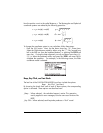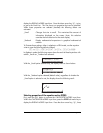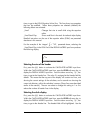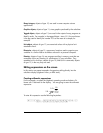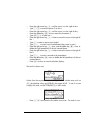
Page 2-2
the CAS, it might be a good idea to switch directly into approximate mode.
Refer to Appendix C for more details.
Mixing integers and reals together or mistaking an integer for a real is a
common occurrence. The calculator will detect such mixing of objects and ask
you if you want to switch to approximate mode.
Complex numbers, are an extension of real numbers that include the unit
imaginary number, i
2
= -1. A complex number, e.g., 3 + 2i, is written as (3, 2)
in the calculator.
Complex numbers can be displayed in either Cartesian or polar mode
depending on the setting selected. Note that complex numbers are always
stored in Cartesian mode and that only the display is affected. This allows the
calculator to keep as much precision as possible during calculations.
Most mathematics functions work on complex numbers. There is no need to use
a special “complex +“ function to add complex numbers, you can use the same
+ function that on reals or integers.
Vector and matrix operations utilize objects of type 3, real arrays, and, if
needed, type 4, complex arrays. Objects type 2, strings, are simply lines of
text (enclosed between quotes) produced with the alphanumeric keyboard.
A list is just a collection of objects enclosed between curly brackets and
separated by spaces in RPN mode (the space key is labeled #), or by
commas in algebraic mode. Lists, objects of type 5, can be very useful when
processing collections of numbers. For example, the columns of a table can be
entered as lists. If preferred, a table can be entered as a matrix or array.
Objects type 8 are programs in User RPL language. These are simply sets of
instructions enclosed between the symbols << >>.
Associated with programs are objects types 6 and 7, Global and Local Names,
respectively. These names, or variables
, are used to store any type of objects.
The concept of global or local names is related to the scope or reach of the
variable in a given program.
An algebraic object, or simply, an algebraic (object of type 9), is a valid
algebraic expression enclosed within quotation or tick marks.



